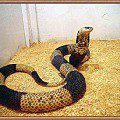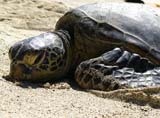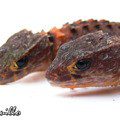
New Guinea skink prickly
The English name for the New Guinea spiny skink is Crocodile. This lizard, indeed, outwardly somewhat resembles an alligator, only “pocket” sizes. Most of all, the similarity is found in the convex, spiked scales that nature endowed this reptile with. The genus of New Guinea skinks is otherwise called helmet-headed, because of the large shields on the sides of the lizard’s head, which are shaped like a helmet. These unique and slightly strange reptiles caught the attention of zoologists back in 1994, when the species was first described. However, there are still many gaps in its study. Many people do not even know about the existence of these lizards.
Contents
Classification
Superclass Quadrupeds
Class Reptiles or Reptiles – Reptilia
Squamous order – Squamata
Suborder Lizards
Infraorder Skinks
Skink family
Genus Casco-headed skinks, crocodile skinks, New Guinea prickly skinks, tribolonotus – Tribolonotus
Appearance
 New Guinea spiny skinks stand out prominently among all reptiles. Their scales resemble the armor or skin of prehistoric animals. On the bony shields of the back and on the tail of the lizards there are pointed cone-shaped keels, for which the skinks were called prickly. The head of these reptiles is triangular in shape, it has pronounced developed cranial arches. Other features that distinguish New Guinea spiny skinks include partially fused premaxillae and one parietal bone, which has a large opening for the parietal eye – the one known as the “third eye” and found only in some reptiles. The teeth of these lizards are pleurodont, that is, located on the inner edge of the jaw. They are about the same size, conical and slightly rounded, and seem to be slightly bent back. There are also reptiles with teeth on the pterygoid bones. The natural originality of the prickly-tailed New Guinea skinks is also manifested in the presence of skin glands on the underside of the toes, similar to the pores that agama lizards have. And of course, different types of spiny skinks have, albeit small, but noticeable differences. They are best seen in the example of the two above-mentioned species – red-eyed and New Guinea. In the first, this is a full-fledged reddish edging of the eyes, and in the second, it is limited only to the area in front of the eye. In addition, the spikes on the back of the New Guinean species are much more pronounced. Let’s take a closer look at these skinks.
New Guinea spiny skinks stand out prominently among all reptiles. Their scales resemble the armor or skin of prehistoric animals. On the bony shields of the back and on the tail of the lizards there are pointed cone-shaped keels, for which the skinks were called prickly. The head of these reptiles is triangular in shape, it has pronounced developed cranial arches. Other features that distinguish New Guinea spiny skinks include partially fused premaxillae and one parietal bone, which has a large opening for the parietal eye – the one known as the “third eye” and found only in some reptiles. The teeth of these lizards are pleurodont, that is, located on the inner edge of the jaw. They are about the same size, conical and slightly rounded, and seem to be slightly bent back. There are also reptiles with teeth on the pterygoid bones. The natural originality of the prickly-tailed New Guinea skinks is also manifested in the presence of skin glands on the underside of the toes, similar to the pores that agama lizards have. And of course, different types of spiny skinks have, albeit small, but noticeable differences. They are best seen in the example of the two above-mentioned species – red-eyed and New Guinea. In the first, this is a full-fledged reddish edging of the eyes, and in the second, it is limited only to the area in front of the eye. In addition, the spikes on the back of the New Guinean species are much more pronounced. Let’s take a closer look at these skinks.
So, a slender red-eyed skink is a baby lizard that grows in length from 6 to 15 cm. At a young age, this reptile is colored quite modestly, most likely in order to better camouflage. The head of young specimens is light yellow or cream with splashes of orange. The lower jaw is lighter in color, while the body is generally dark brown. The bright rim of the eyes appears in slender skinks over time. The abdomen of lizards is light. With age, their body color darkens noticeably, but a light brown collar remains on the neck.
The New Guinea spiny skink is somewhat larger than the slender skink. The size of an adult is about 20 cm. And it is painted in lighter brown tones with cream transverse stripes on the body and tail. During the breeding season, some parts of the body of the spiny New Guinea skinks may turn a brighter orange color.
The most famous are two species from the genus Tribolonotus – the red-eyed or slender skink, which differs from its counterparts in the red-orange eye rim, and the New Guinean skink, which does not have such a difference, but is also recognizable at first sight. New Guinea spiny skinks are quite rare pets in home terrariums. More often they are kept in specialized nurseries and zoos, since the features of the existence of these skinks have not yet been sufficiently studied. For the same reason, it is only possible to purchase wild-caught lizards of this genus.
Males in all species of skinks are larger than females. Among other species, the following are known: T. annectens, T. blanchardi, T. Brongersmai, T. Ponceleti, T. pseudoponceleti, T. Schmidti.
Distribution and habitation
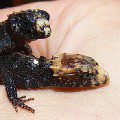 All of the spiny New Guinea skinks spread eastward from Indonesia through New Britain to the Solomon Islands in the Pacific. Each species in this area occupies its own area. For example, a slender spiny skink is found in Papua New Guinea on the Admiralty or Manus Islands, and a typical New Guinean skink lives in the west of the island of New Guinea, known as West Irian. Several different species are also found in the Solomon Islands. And although the climate in this area is quite diverse – there are tropical forests, arid savannahs and even snowy mountains, spiny skinks carefully choose biotopes, and in this respect are quite demanding. They prefer predominantly humid forest tropics, an area near fresh water sources, where there is a lot of different vegetation, because under it ground skinks can easily hide and find food. And they are often found on coconut plantations. However, herpetologists note that in general, spiny New Guinea lizards easily adapt to new habitat conditions, so they take root well in captivity.
All of the spiny New Guinea skinks spread eastward from Indonesia through New Britain to the Solomon Islands in the Pacific. Each species in this area occupies its own area. For example, a slender spiny skink is found in Papua New Guinea on the Admiralty or Manus Islands, and a typical New Guinean skink lives in the west of the island of New Guinea, known as West Irian. Several different species are also found in the Solomon Islands. And although the climate in this area is quite diverse – there are tropical forests, arid savannahs and even snowy mountains, spiny skinks carefully choose biotopes, and in this respect are quite demanding. They prefer predominantly humid forest tropics, an area near fresh water sources, where there is a lot of different vegetation, because under it ground skinks can easily hide and find food. And they are often found on coconut plantations. However, herpetologists note that in general, spiny New Guinea lizards easily adapt to new habitat conditions, so they take root well in captivity.
Behavior and lifestyle
The main data on the behavior of the New Guinea spiny skinks have been obtained from observation of them in terrariums. It is known that these lizards lead a twilight terrestrial lifestyle, preferring to hide in dry foliage or coconut substrate in case of danger. They hunt at sunset and at dawn and are generally quite shy creatures, so they hide most of the time. Only the desire to swim can make a prickly skink leave the shelter – New Guinean skinks are very fond of water and especially often plunge into it before molting, freezing in immobility and spending so much time. So if you have such a pocket crocodile in your terrarium, don’t forget to put a shallow but spacious container of water for him so that the skink can comfortably fit in it. In all other respects, the New Guinea spiny skinks are quite sensitive. They cannot stand the cold, which makes them easily catch cold, long journeys, which make them thin and dehydrated, and active intrusion into personal space, having felt which, they can begin to make sounds similar to quacking. Recognizing the disease state of a lizard is simple. In the red-eyed skink, the orange rim of the eyes immediately turns pale. If this happens, the pet may need to be treated.
Food
New Guinea spiny skinks easily find their food in the same place where they live. In tropical thickets there are many insects that are tasty for them: small larvae, worms, snails, slugs, crickets. Some invertebrate skinks are also caught in the water. In captivity, it is recommended to create the most varied diet for lizards with the addition of calcium and vitamin D3. Feeding young animals differs from adults in that young individuals should be fed every day, and mature enough food three times a week. It is also not recommended to overfeed the New Guinea spiny skinks with various worms, as these insects contain a high percentage of fat. And the owners practically do not manage to watch how the skink eats. He prefers to do this when no one is watching, due to his circadian rhythms – late in the evening or early in the morning. So do not be afraid if it seems to you that the lizard does not eat anything. It is enough to pay attention to whether the amount of food that you put on it decreases, and everything will immediately clear up. By the way, zoologists affectionately call such secrecy of the New Guinean prickly skinks “shyness”.
Reproduction
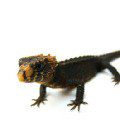 Sexual dimorphism in spiny New Guinea skinks appears around the third year of life. Males are usually larger than females, but females are more rounded in body shapes. In addition, the males have the already mentioned gray or blue pores on some of the toes. It is assumed that they are responsible for the release of pheromones. And females are distinguished by the presence of a convex square on the abdomen in the area of uXNUMXbuXNUMXba possible navel, sometimes it is called the abdominal press. Spiny-tailed New Guinea skinks are not particularly fertile, and they only breed if the environment is to their liking. Therefore, lizards should be especially carefully taken care of during the breeding season in captivity. In particular, for normal reproduction of their own kind, they need high humidity, since in nature skinks mate during the rainy season. And in the terrarium, you will have to constantly spray their home.
Sexual dimorphism in spiny New Guinea skinks appears around the third year of life. Males are usually larger than females, but females are more rounded in body shapes. In addition, the males have the already mentioned gray or blue pores on some of the toes. It is assumed that they are responsible for the release of pheromones. And females are distinguished by the presence of a convex square on the abdomen in the area of uXNUMXbuXNUMXba possible navel, sometimes it is called the abdominal press. Spiny-tailed New Guinea skinks are not particularly fertile, and they only breed if the environment is to their liking. Therefore, lizards should be especially carefully taken care of during the breeding season in captivity. In particular, for normal reproduction of their own kind, they need high humidity, since in nature skinks mate during the rainy season. And in the terrarium, you will have to constantly spray their home.
Observers of the behavior of spiny New Guinea skinks during the breeding season claim that the male courts the female in a special way. Whether this happens in nature is unknown. However, in the terrarium, the male approaches the chosen one, nodding his head and puffing his throat wide, and then begins to walk around her until the female gives a sign of favor. When mating, the male grabs the girl by the neck and wraps his tail around her tail.
According to the method of reproduction, spiny New Guinea skinks are mostly oviparous, but, unlike most reptiles, their laying is limited to only one egg. True, it happens up to 6 times a year. And limited fertility is explained by partial or complete loss of functions in some species of the left oviduct. Although, perhaps, and vice versa – a decrease in the number of eggs over time contributed to such changes. On the other hand, scientists suggest that in some skink species, embryos began to develop directly in the active oviduct. But, one way or another, the females of these lizards have only one ovary. There are also viviparous spiny skinks. For example, the species Tribolonotus schmidti, the female of which gives birth to one baby. But this feature is rare both in this genus and in reptiles in general. As for oviparous skinks, their females lay one egg covered with a leathery shell. In terrariums, such eggs are placed in an incubator, but they should be taken carefully from the female, since she tends to actively protect the masonry. The incubation period is 3 to 4 months. An embryo can develop normally only if there is sufficient humidity and a high temperature around – 22-27 degrees.
The young do not hatch immediately, but pierce the leathery shell of the egg several times so that air gets inside, and only then expands this gap and gets out. New Guinea prickly skinks are born very small, about 5-6 cm in size. They, like adults, are distinguished by their peculiar behavior. If the little skink is frightened of something, then he immediately falls and pretends to be dead, while trying to hardly breathe. In this state, it is not recommended to touch the babies until they get used to the presence of a person. And over time, skinks turn into cheerful and active creatures that begin to hunt immediately after the first molt.
Sources of
http://en.wikipedia.org/
http://www.tribolonotus.com
www.floranimal.ru
http://terraria.ru/



